|
|
|
Sort Order |
|
|
|
Items / Page
|
|
|
|
|
|
|
| Srl | Item |
| 1 |
ID:
197986


|
|
|
|
|
| Summary/Abstract |
Amid United States-led efforts to internationalize and multilateralize support for Taiwan and cross-Strait deterrence in response to mounting coercive pressure from China, the April 2021 and May 2021 U.S.-Japan and U.S.-South Korea summit statements’ unprecedented references to ‘peace and stability across the Taiwan Strait’ triggered global headlines. In the 3 years since, U.S. expectations for treaty allies to do and say more in support of Taiwan and cross-Strait deterrence have surged. But what of the perspectives and policies of key front-line treaty allies Japan and Korea, each host to tens of thousands of forward-deployed U.S. forces? This study comparatively analyzes the historical and contemporary evolution of Japanese and Korean positions and policies vis-à-vis Taiwan and the role their leaders see for their country and respective alliance with the U.S. in the event of a ‘regional contingency’: a conflict not involving—at least initially—armed attacks on ally-administered territory. After highlighting the similarities between Seoul’s and Tokyo’s intentionally ambiguous positions on Taiwan’s status, it explores important differences in each allies’ willingness to deepen practical engagement with Taiwan, to expand their respective alliance’s focus beyond territorial defense, and to stretch the bounds of the ally’s own potential contributions in a regional contingency.
|
|
|
|
|
|
|
|
|
|
|
|
|
|
|
|
| 2 |
ID:
159829
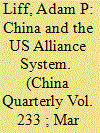

|
|
|
|
|
| Summary/Abstract |
In recent years, scholarship examining US and security allies’ responses to China's rapidly growing power and “assertive” policies towards its neighbours has proliferated. The English-language literature remains relatively one-sided, however. Crucial to understanding the complex forces driving strategic competition in the contemporary Asia-Pacific are comprehensive surveys of how Chinese views are evolving. This study draws extensively on Chinese sources to update existing scholarship, much of it two decades old, with a particular focus on recent Chinese reactions to major developments concerning the US-centred alliance system – a foundational element of the 65-year-old regional order. Beijing expresses deepening frustration towards, and even open opposition to, recent alliance strengthening, and instead champions alternative security architectures free of what it alleges to be “exclusive,” “zero-sum,” “Cold-war relic” US-centred alliances. Proposals for concrete pathways to operationalizing these abstract visions that take into account contemporary political and security realities (for example, North Korea), however, appear less forthcoming.
|
|
|
|
|
|
|
|
|
|
|
|
|
|
|
|
| 3 |
ID:
113866
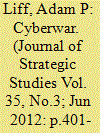

|
|
|
|
|
| Publication |
2012.
|
| Summary/Abstract |
This article examines the implications of the proliferation of cyberwarfare capabilities for the character and frequency of war. Consideration of strategic logic, perceptions, and bargaining dynamics finds that the size of the effect of the proliferation of cyberwarfare capabilities on the frequency of war will probably be relatively small. This effect will not be constant across all situations; in some cases the advent of cyberwarfare capabilities may decrease the likelihood of war. On the other hand, the use of computer network attack as a brute force weapon will probably become increasingly frequent.
|
|
|
|
|
|
|
|
|
|
|
|
|
|
|
|
| 4 |
ID:
124888
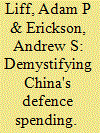

|
|
|
|
|
| Publication |
2013.
|
| Summary/Abstract |
China's limited transparency concerning its defence spending harms strategic trust, but foreign analysts often lose sight of important realities. Specific details remain unclear, but China's defence spending overall is no mystery - it supports PLA modernization and personnel development as well as its announced objectives of securing China's homeland and asserting control over contested territorial and maritime claims, with a focus on the Near Seas (the Yellow, East, and South China seas). This article offers greater context and perspective for Chinese and Western discussions of China's rise and concomitant military build-up through a nuanced and comprehensive assessment of its defence spending and military transparency.
|
|
|
|
|
|
|
|
|
|
|
|
|
|
|
|
| 5 |
ID:
153322
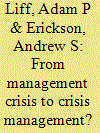

|
|
|
|
|
| Summary/Abstract |
Since 2012, China’s assertion of its sovereignty claim to the contested Senkaku/Diaoyu Islands has significantly raised the risk of a potentially escalatory political-military crisis with Japan. As circumstances worsen, Japanese Prime Minister Shinzo Abe has championed major institutional reforms aimed at centralizing Japanese security policy decision-making and vastly improving crisis management. This article assesses these reforms’ significance for ameliorating Japan’s long-standing internal crisis management weaknesses, and enhancing its ability to communicate with Beijing promptly under challenging conditions. While significant issues remain, recent developments – especially the establishment of Japan’s first-ever National Security Council – demonstrate significant progress. Bilaterally, however, important firebreaks remain conspicuously absent.
|
|
|
|
|
|
|
|
|
|
|
|
|
|
|
|
| 6 |
ID:
179242
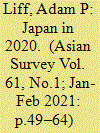

|
|
|
|
|
| Summary/Abstract |
Japan’s leaders began 2020 with grand ambitions to make it a historic year. Tokyo was set to welcome the world for the Summer Olympics, Japan’s first since 1964, and Abe Shinzō, the powerful prime minister, planned to realize his party’s 65-year-old dream: revising Japan’s never-amended, US-drafted 1947 constitution. By spring, however, it was clear that COVID-19 had other plans. Despite public health outcomes better than in any other G7 member, daily life was severely disrupted, and the domestic political and economic fallout for Japan was significant. By late summer, circumstances were improving, but both Abe’s popularity and his personal health had suffered. He resigned in September, ending the longest prime-ministership in Japanese history. Though COVID-19 and the end of the Abe Era were the major storylines of Japan in 2020, a subplot was, paradoxically, remarkable continuity in national politics and foreign affairs.
|
|
|
|
|
|
|
|
|
|
|
|
|
|
|
|
| 7 |
ID:
185198


|
|
|
|
|
| Summary/Abstract |
For Japan in 2021, COVID-19-related disruption was again the dominant storyline. Its impact transcended societal consequences to affect Japan’s economy, politics, and foreign affairs. It frustrated Japan’s economic recovery and, for the second time in as many years, contributed to a prime minister’s premature resignation. Yet the year also witnessed major positive developments, including the “2020” Tokyo Olympics/Paralympics; an (eventually) successful vaccine rollout; public health outcomes vastly better than those of any other G7 member; an expected return to economic growth; and a smooth national election. On October 31, new prime minister Kishida Fumio led the ruling LDP–Komeito coalition into Japan’s first general election since 2017. Despite losing a few seats, it retained a comfortable lower-house majority, ensuring that a subplot for Japan in 2021 was—again—relative continuity in national politics and foreign affairs.
|
|
|
|
|
|
|
|
|
|
|
|
|
|
|
|
| 8 |
ID:
189499
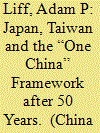

|
|
|
|
|
| Summary/Abstract |
This study analyses the “one China” framework's significance for Japan–Taiwan relations since Tokyo switched diplomatic recognition from Taipei to Beijing in 1972. Drawing on Chinese-, Japanese- and English-language sources, it examines developments since the breakthrough Japan–PRC normalization communiqué and the “Japan formula,” which enabled Tokyo to normalize relations – six years before Washington – without recognizing Beijing's claim of sovereignty over Taiwan, and while maintaining robust, if unofficial, ties with Taipei thenceforth. Highlighting distinctions between Beijing's self-asserted “one-China principle” and Japan's ambiguous official position and subsequent effective policies, it assesses incremental but practically significant evolutions of Japan–Taiwan relations over the past half-century. In the 21st century, the trend towards incrementally closer ties has proven strikingly resilient to political transitions in Japan and Taiwan, China's growing power, pushback from Beijing and worsening cross-Strait frictions. Beyond Japan–Taiwan relations and theoretical debates on “one China,” this article's findings carry significant implications for Taiwan's international space, cross-Strait dynamics and China–Japan–United States relations.
|
|
|
|
|
|
|
|
|
|
|
|
|
|
|
|
| 9 |
ID:
161730
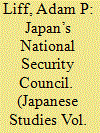

|
|
|
|
|
| Summary/Abstract |
In 2013, Japan established its first-ever National Security Council (NSC) as the leading edge of ambitious reforms to its foreign-policy-relevant institutions. Within weeks, Japan’s new national security tripod was firmly in place: the top-level, political NSC ‘control tower’ as well as Japan’s first-ever National Security Strategy and National Security Secretariat. Ever since, the NSC has played a central role in every major aspect of the Japanese strategic trajectory that has attracted so much global attention (and controversy) in the ‘Abe era’. This study analyzes the motivations driving Japan’s decision to establish an NSC, the institution’s key characteristics and functioning, and offers a preliminary assessment of the current and likely future implications of this historic institutional reform. Beyond the NSC’s impact on policy, of potentially greater long-term significance is its effects on Japan’s foreign-policy decision-making processes: in particular, expanded Kantei-centered political leadership of national security affairs and more ‘whole-of-government’ approaches specifically designed to transcend the ‘vertical hurdles’ traditionally dividing Japan’s powerful bureaucracies. The goal of these reforms is as straightforward as it is ambitious: to transform Japan’s ability to flexibly and independently cope with a rapidly changing, increasingly complex, and ever more uncertain security environment in East Asia and beyond.
|
|
|
|
|
|
|
|
|
|
|
|
|
|
|
|
| 10 |
ID:
190374
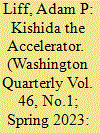

|
|
|
|
|
| Summary/Abstract |
Japanese Prime Minister Fumio Kishida’s January 2023 summit with President Biden capped one of the most significant months for Japanese defense policy in decades. On December 16, Kishida’s government announced a strikingly ambitious revision of Japan’s national security strategy—the first since 2013. Part of a package of three major security documents also including Japan’s new national defense strategy and defense buildup plan, last December’s announcements are as remarkable for the substantive ambition and breadth of the pledges contained within as for what they reveal about rapidly worsening concerns in Japan about regional and global geopolitical and geo-economic trends.
|
|
|
|
|
|
|
|
|
|
|
|
|
|
|
|
| 11 |
ID:
189495
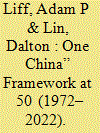

|
|
|
|
|
| Summary/Abstract |
This lead article surveys the history and evolving policy legacies of the “one China” framework 50 years after US President Richard Nixon's historic 1972 visit to China. It begins by introducing key concepts and highlighting the crucial difference between Beijing's self-defined “one-China principle” and the US's, Japan's and key other countries’ variable “one China” policies as it relates to Taiwan. It argues that three seminal 1970s developments consolidated the “one China” framework as an informal institution of international politics. The ambiguity baked in by Cold War-era geopolitical necessity provided flexibility sufficient to enable diplomatic breakthroughs between erstwhile adversaries, but also planted seeds for deepening contestation and frictions today. Recent developments – especially Taiwan's democratization and Beijing's increasingly bold and proactive assertion of its claim to sovereignty over Taiwan – have transformed incentive structures in Taipei and for its major international partners. The net effect is that the myth of “consensus” and the ambiguities enabling the framework's half-century of success face unprecedented challenges today.
|
|
|
|
|
|
|
|
|
|
|
|
|
|
|
|
| 12 |
ID:
120291
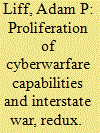

|
|
|
| 13 |
ID:
135331


|
|
|
|
|
| Summary/Abstract |
In the post–Cold War period, scholars have considered the Asia Pacific to be ripe for military competition and conflict. Developments over the past decade have deepened these expectations. Across the region, rising military spending and efforts of various states to bolster their military capabilities appear to have created an increasingly volatile climate, along with potentially vicious cycles of mutual arming and rearming. In this context, claims that China's rapid economic growth and surging military spending are fomenting destabilizing arms races and security dilemmas are widespread. Such claims make for catchy headlines, yet they are rarely subject to rigorous empirical tests. Whether patterns of military competition in the Asia Pacific are in fact attributable to a security dilemma–based logic has important implications for international relations theory and foreign policy. The answer has direct consequences for how leaders can maximize the likelihood that peace and stability will prevail in this economically and strategically vital region. A systematic empirical test derived from influential theoretical scholarship on the security dilemma concept assesses the drivers of bilateral and multilateral frictions and military competition under way in the Asia Pacific. Security dilemma–driven competition appears to be an important contributor, yet the outcome is not structurally determined. Although this military competition could grow significantly in the near future, there are a number of available measures that could help to ameliorate or manage some of its worst aspects.
|
|
|
|
|
|
|
|
|
|
|
|
|
|
|
|
| 14 |
ID:
192118
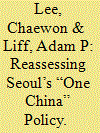

|
|
|
|
|
| Summary/Abstract |
Amid U.S.-led efforts to “internationalize and multilateralize” support for Taiwan in response to mounting pressure from China, the 2021 U.S.-South Korea presidential statement’s unprecedented reference to “peace and stability across the Taiwan Strait” made global headlines. This study analyzes contemporary Korea-Taiwan relations in historic and comparative perspective, focusing especially on Seoul’s official 1992 position on “One China” and its implications for Korea’s Taiwan policy. It demonstrates that Seoul has never recognized Beijing’s self-defined “One China principle” concerning its essential claim of PRC sovereignty over Taiwan. Comparative analysis of Korea’s position and subsequent policies with the U.S.’, Japan’s, and others’ further reveals significant (potential) flexibility in Korea’s approach to Taiwan. The relatively distant state of Korea-Taiwan relations today is the collective political choice of Korea’s democratically-elected leaders—not the legacy of some (non-existent) putative commitment made to Beijing 30 years ago.
|
|
|
|
|
|
|
|
|
|
|
|
|
|
|
|
| 15 |
ID:
147908
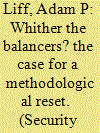

|
|
|
|
|
| Summary/Abstract |
Post-Cold War, balancing theory has fallen on “hard times.” A question of crucial importance for 21st-century peace and stability concerns how Asia–Pacific secondary states are responding militarily to China's rise. China's rapid growth, military modernization, and controversial policies vis-à-vis contested space and territories on its periphery make it a prime candidate for counterbalancing behavior. Yet several recent studies claim that secondary states are accommodating, even bandwagoning with, Beijing. This study challenges these claims, attributing them largely to problematic research designs not uncommon in the wider balancing literature. It proposes a methodological corrective, arguing for widespread employment of an alternative analytical framework relying on clearer definitions and explicitly delineated sets of 21st-century-relevant metrics reflecting the myriad ways contemporary militaries enhance their capabilities in response to perceived threats. Applied systematically to original analysis of the contemporary Asia–Pacific, this framework uncovers what existing studies miss—evidence of practically significant and accelerating balancing against China.
|
|
|
|
|
|
|
|
|
|
|
|
|
|
|
|
|
|
|
|
|